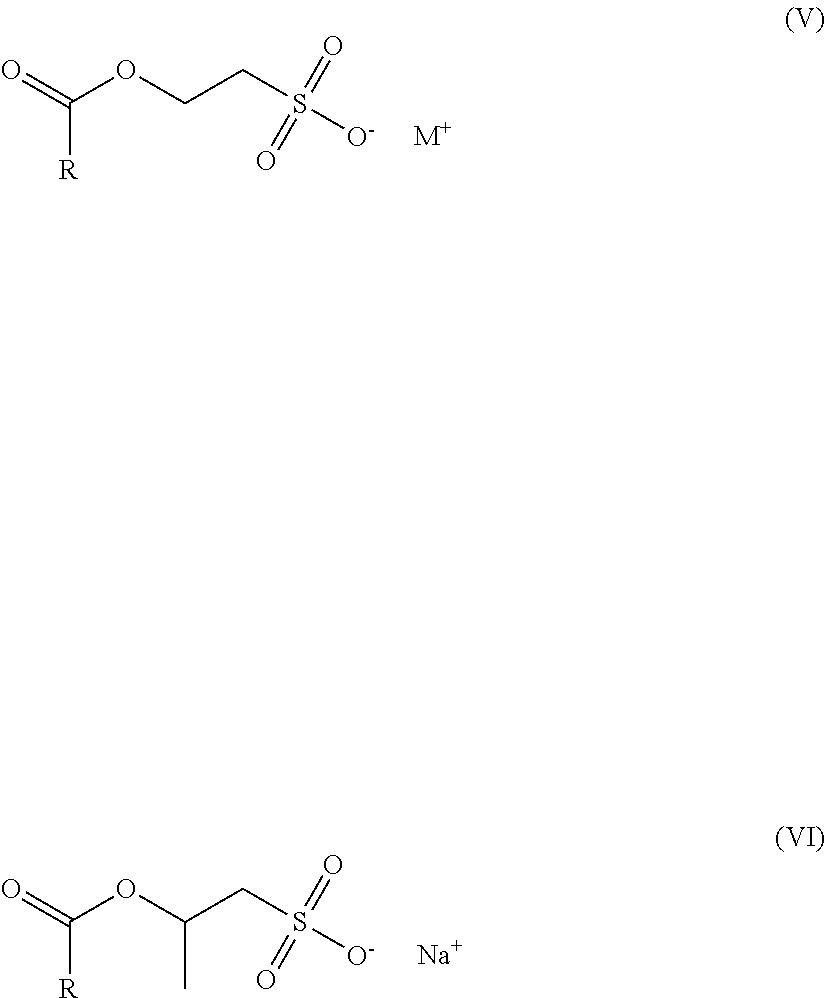Cleansing compositions free of sodium chloride and sulfate-based surfactants
a technology of surfactants and cleaning compositions, applied in the field of cleaning compositions, can solve the problems of high hygroscopicity, harshness of sodium chloride-based surfactants, dry and texturized hair and body, etc., and achieve the effects of less runny, increased viscosity, and cleansing composition structur
- Summary
- Abstract
- Description
- Claims
- Application Information
AI Technical Summary
Benefits of technology
Problems solved by technology
Method used
Image
Examples
example
Inventive Compositions
[0286]
INCI USABCD(a)(i)Acyl isethionatesSODIUM LAUROYL METHYL ISETHIONATE10.110.110.110.1(ii)Acyl SarcosinateSODIUM LAUROYL SARCOSINATE2.42.42.42.4(b)alkyl amphoproprionatesSODIUM COCOAMPHOPROPIONATE4444(c)(i)AlkanolamideCOCAMIDE MIPA3333(ii)Alkyl PolyglucosideDECYL GLUCOSIDE1.11.11.11.1(iii)MiscellaneousPEG-100 STEARATE, PEG-150 DISTEARATE, PPG-5-2.52.51.42.4NonionicCETETH-20, TRIDECETH-10, PEG-55 PROPYLENESurfactantsGLYCOL OLEATE AND / OR STEARETH-6(d)Hydrophobically ModifiedACRYLATES / BEHENETH-25 METHACRYLATE0.30.2Poly(meth)acrylateCOPOLYMER(e)SiliconesAMODIMETHICONE AND / OR DIMETHICONE11(g)Cationic ConditioningHYDROXYPROPYL GUAR0.20.20.20.2PolymerHYDROXYPROPYLTRIMONIUM CHLORIDENon-Silicone FattyGLYCOL DISTEARATE1.41.4CompoundsMORINGA OLEIFERA SEED OIL, SUNFLOWER SEED0.010.010.20.4OIL, COCONUT OIL, AND / OR ORBIGNYA OLEIFERASEED OIL(h)Thickening AgentCARBOMER0.20.2(i)Water-Soluble SolventsPROPYLENE GLYCOL AND / OR BUTYLENE GLYCOL0.40.40.40.5MiscellaneousFRAGRANCE(S)...
example 2
Comparative Testing
[0287]
INCI USACOMPARATIVE A(a)(i)Acyl isethionatesSODIUM LAUROYL METHYL ISETHIONATE10.110.1(ii)Acyl SarcosinateSODIUM LAUROYL SARCOSINATE2.42.4(b)alkyl amphoproprionatesSODIUM COCOAMPHOPROPIONATE4(c)(i)AlkanolamideCOCAMIDE MIPA33(ii)Alkyl PolyglucosideDECYL GLUCOSIDE1.11.1(iii)MiscellaneousPEG-100 STEARATE, PEG-150 DISTEARATE, PPG-5-2.52.5NonionicCETETH-20, TRIDECETH-10, PEG-55 PROPYLENE GLYCOLSurfactantsOLEATE, AND / OR STEARETH-6(d)Hydrophobically ModifiedACRYLATES / BEHENETH-25 METHACRYLATE COPOLYMER0.3Poly(meth)acrylate(e)SiliconesAMODIMETHICONE AND / OR DIMETHICONE11(g)Cationic ConditioningHYDROXYPROPYL GUAR HYDROXYPROPYLTRIMONIUM0.20.2PolymerCHLORIDENon-Silicone FattyGLYCOL DISTEARATE1.41.4CompoundsMORINGA OLEIFERA SEED OIL, SUNFLOWER SEED OIL,0.010.01COCONUT OIL, AND / OR ORBIGNYA OLEIFERA SEED OIL(h)Thickening AgentCARBOMER0.20.2(i)Water-Soluble SolventsPROPYLENE GLYCOL AND / OR BUTYLENE GLYCOL0.40.4MiscellaneousFRAGRANCE(S), COLORANT(S), PRESERVATIVE(S),≤3≤3CHELATI...
PUM
| Property | Measurement | Unit |
|---|---|---|
| wt. % | aaaaa | aaaaa |
| wt. % | aaaaa | aaaaa |
| wt. % | aaaaa | aaaaa |
Abstract
Description
Claims
Application Information
 Login to View More
Login to View More - R&D
- Intellectual Property
- Life Sciences
- Materials
- Tech Scout
- Unparalleled Data Quality
- Higher Quality Content
- 60% Fewer Hallucinations
Browse by: Latest US Patents, China's latest patents, Technical Efficacy Thesaurus, Application Domain, Technology Topic, Popular Technical Reports.
© 2025 PatSnap. All rights reserved.Legal|Privacy policy|Modern Slavery Act Transparency Statement|Sitemap|About US| Contact US: help@patsnap.com



